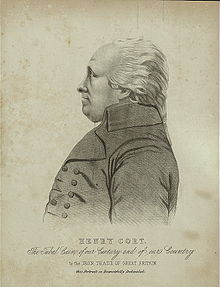Henry Cort
Henry Cort (* 1740 in Lancaster ; † 23 May 1800 ) was an English entrepreneur and metallurgist during the Industrial Revolution in England . In 1783 he patented a mechanical rolling process in iron production and in 1784 invented the puddling process for the production of wrought iron ( steel ) from pig iron, which became the basis of wrought iron production in the 19th century.
Life
Henry Cort was the son of a builder, but little is known of his youth. From 1765 he worked successfully as a Navy Agent (marine outfitter) in London, where he acquired knowledge of the different quality of various iron products for shipping. He only got an insight into the practice of a smelting business in 1772 in the hut of an uncle of his wife's. In 1775 he gave up his business as a Navy agent and bought a hammer forge , probably less for technical reasons than to be able to realize outstanding claims. In 1780 he signed a contract with the Royal Navy for the supply of iron tires for ship masts in exchange for scrap tires, which were coveted as raw materials, and therefore expanded his business to include a rolling and cutting plant.
In 1783 he patented a rolling and cutting process with grooved rollers and in 1784 the puddling process , in which instead of the increasingly scarce and expensive charcoal , the abundant and cheap hard coal could be used for the first time to convert pig iron into wrought iron.
The contract with the Navy was successful, but of course did not provide the necessary liquidity. He received part of the required capital from Adam Jellicoe, the vice-paymaster of the Navy, to whom he pledged his patents for security reasons and took his son into the business, now called Cort & Jellicoe. When Adam Jellicoe died unexpectedly, it was revealed that he had left considerable debts and had taken the loan to Cort from the Navy coffers. The Navy sued Cort & Jellicoe for damages. Various cases of corruption in the Navy and in the treasury prevented Cort from fulfilling the demands and brought him to his patents and other assets. After prolonged efforts he received only a small pension and died impoverished on May 23, 1800. He left behind his widow and ten children.
Cort was married twice: to Elizabeth Brown and in 1768 to Elizabeth Heysham. He is buried in Hampstead , London.
literature
- Akoš Paulinyi: Puddling: a chapter in the history of iron in the industrial revolution. Munich, Oldenbourg-Verlag 1987 (together with the Deutsches Museum), ISBN 3-486-26200-9
- RA Mott (ed.P. Singer), Henry Cort: the Great Finer (The Metals Society, London 1983)
- HW Dickinson, Henry Cort's Bicentenary, in The Newcomen Society , Transactions 1940-41, volume XXI, 1943
Web links
- Robert Hunt: Cort, Henry . In the Dictionary of National Biography
- Henry Cort - short biography
- Henry Cort - another short biography
- The Gosport Iron Foundry and Henry Cort (English)
- Encyclopedia of World Biography on Henry Cort
- History of Henry Cort (English)
- Puddle steel
| personal data | |
|---|---|
| SURNAME | Cort, Henry |
| BRIEF DESCRIPTION | English metallurgist and entrepreneur; Inventor of the puddling process |
| DATE OF BIRTH | 1740 |
| PLACE OF BIRTH | Lancaster , England |
| DATE OF DEATH | May 23, 1800 |
| Place of death | unsure: London |
